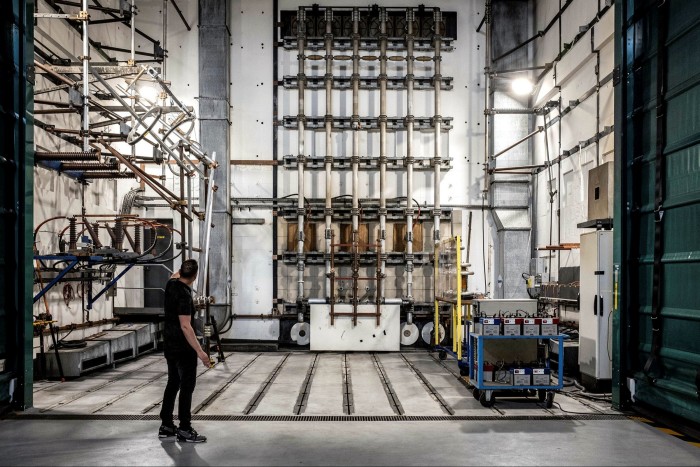Investors push for faster ways to save energy

Simply sign up to the Energy sector myFT Digest -- delivered directly to your inbox.
One of the world’s most powerful tools for combating climate change is also one of the most overlooked: energy efficiency.
While it does not grab the headlines, every incremental effort to reduce energy consumption is vital if the world is to hit the Paris Agreement’s target of keeping global warming below 1.5C.
The potential of energy efficiency measures to cut emissions is undeniable.
However, a report last month on recent progress in rolling out energy-saving measures, published by the International Energy Agency, is damning. It found that global improvements have been well short of what is needed to put the world on track to reach net zero emissions by 2050. And the rate of improvements has been sliding since 2015, falling to its slowest in a decade in 2020.
“There is no plausible pathway to net zero emissions without using our energy resources much more efficiently,” said Fatih Birol, IEA executive director, on publication of the report.
The slow pace of investment has left facilitators — from electrical and capital goods companies to software providers and investment funds — exasperated that many businesses have still not taken readily available opportunities to reduce their carbon footprint.
Jonathan Parr — a fund manager at Triple Point Energy Efficiency Infrastructure Company, which invests in projects such as recovering waste heat from industrial sites and retrofitting insulation or heat pumps in homes — says government incentives initially made renewable power projects attractive, but they have been winding down.
“The very low-hanging fruit has now disappeared,” he says. “The balance has shifted somewhat.” He adds that “decarbonisation still carries a stigma that it’s more expensive than other polluting alternatives”.
Frustration has been compounded by the fact that the incentive to cut energy use should now be even higher as power bills have surged due to soaring gas prices.
Katie McGinty, vice-president and chief sustainability and external relations officer at Johnson Controls, which makes heating, ventilation and air conditioning equipment, compares the missed opportunity in energy efficiency to “$20 bills littering the sidewalk and nobody [picking] them up”.
She says big barriers to adoption have included a misalignment of interests — often, builders and owners do not want to upgrade buildings even if the tenants do — and the US federal government not taking the same lead on building standards as it does for appliances or cars.

Olivier Blum, chief strategy and sustainability officer at Schneider Electric, a French electrical equipment and software group, says that the customer’s return on investment for energy efficiency projects is typically three years, but “the corporate world was slow to start”.
However, he noticed signs of change around 2018 as the ambitions of the Paris Climate Agreement of 2015 seeped through to boardrooms in the form of net zero commitments, which are now being converted into action.
“We see it coming,” he says. “It’s coming from investors and boards.”
Parr says it is not just the pledges from private companies that are now driving momentum behind energy efficiency projects. “Housing associations and local authorities have been given clear instructions that they must decarbonise their housing stock,” he notes.
Executives at groups involved in energy efficiency are also becoming more bullish that investment will flood into the sector.
A need to triple annual investment in the sector worldwide by 2030 to hit net zero targets, plus companies’ need to demonstrate their progress, have driven this gear shift, the executives say.
“We have realised that buildings represent 40 per cent of global greenhouse gas emissions, and there’s no decarbonising the planet without decarbonising buildings,” explains McGinty. “It has brought energy efficiency into the pantheon of tools next to solar, wind and electric vehicles.”
That realisation has contributed to a rally in the shares prices of efficiency-enabling companies, helped by a rebound in manufacturing output after the initial impact of the Covid pandemic.
Twice weekly newsletter

Energy is the world’s indispensable business and Energy Source is its newsletter. Every Tuesday and Thursday, direct to your inbox, Energy Source brings you essential news, forward-thinking analysis and insider intelligence. Sign up here.
Shares in Schneider Electric and Johnson Controls have almost doubled in price over two years, and hit record highs last week. Britain’s Spirax Sarco Engineering, which makes steam management systems — an industrial staple that accounts for a ninth of US energy use, according to the country’s Department of Energy — has also enjoyed a share price boost.
Scott Cagehin, an analyst at Investec, says investors are now on the hunt for less obvious industrial winners from the drive towards energy efficiency.
“The likes of Schneider, Vestas and Spirax have run their course in terms of being well known as ESG friendly,” he says. “Who shall we look at who is not [yet] acknowledged for that?”
His advice is: “You’ve got to sift through those putting ESG [environmental, social and governance criteria] slides in their pack just to improve their own credentials and then look at who is winning business and growing revenues because customers are wanting to buy their products to improve their own sustainability.”
However, Blum of Schneider Electric warns of a moment of reckoning as many industrial companies try to jump on the energy efficiency bandwagon.
“Many companies have seen a re-rating because of sustainability, but there will be a re-rating up and down of people that have talked about it and those who deliver it,” he says.

Comments